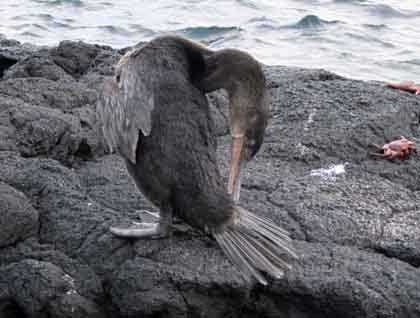Originally named Albemarle after the Duke of Albemarle, Isabela is one of the youngest islands. It is located on the western edge of the archipelago near the Galapagos hotspot and crossed by the Equator line. Just in front of Isabela and surrounded on all sides by the black lava fields, Fernandina looks impressive with its gigantic volcano in the middle of the island.
After a long navigation from Rabida Island, early in the morning we woke up sailing toward the largest island in the archipelago, Isabela Island. With a wavy ocean and cloudy sky we started our day trying to find sea life along the Bolivar channel. We observed sea birds in feeding frenzy, some sea lions swimming and jumping as dolphins and ocean sun fish or mola mola whose unmistakable dorsal fin captivated our guests who enjoyed the spectacular view from the top deck of the National Geographic Islander. Soon after we crossed the Equator, we dropped anchor on Punta Vicente Roca, which lays on the foot of the gigantic Ecuador volcano. We started our Zodiac ride along the coast searching for unique wildlife such as Galapagos penguins, green sea turtles, flightless cormorants and seabirds. After our Zodiac ride, we came back to snorkel, discovering an incredible undersea world. As soon we got to the water we were surrounded by sea turtles that swam indifferently close to us. We observed males, females, and juveniles swimming or resting on the bottom like rocks. We observed flightless cormorants chasing some fish and on the rocks, Galapagos penguins dried out their wings under the attentive eyes of our guests. Unique creatures like nowhere else.
Back onboard and after lunch, and while we navigated to Fernandina Island, I talked about human history of the Galapagos. Afterwards we headed into Zodiacs to visit Punta Espinoza on Fernandina. Its surrealistic and barren landscape contrasted with the explosion of life found there. Everywhere we walked we observed a large number of marine iguanas whose black bodies looked as petrified as the rocks. On beaches, sea lions rested or nursed their babies and finally along the way, we could find our next non-flying bird, the flightless cormorant. We observed some on the rocks drying their wings and others in the water collecting algae or catching some fish. We felt as the marine breeze became fresh, the sunset along the west was calling all sea birds back to their nests and giving us a final view of this magical place: a whale in the distance with its unmistakable spray, and lot of shear waters trying to catch some food near the great creature. Finally we arrived back on board tired but happy, because we enjoyed this beautiful paradise called Galapagos.







